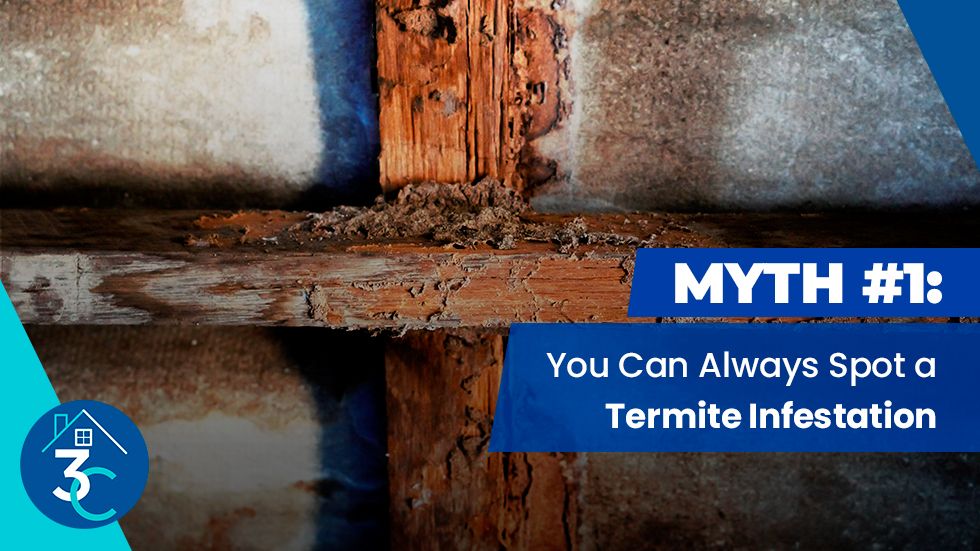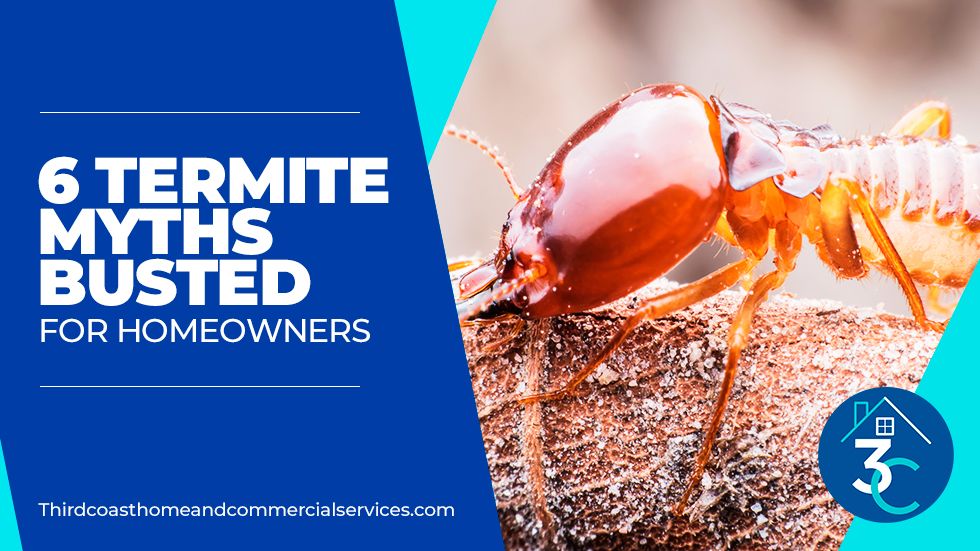Every year in the United States, termite infestations affect over 600,000 homes. They also are responsible for almost $40 billion in annual damage throughout the world.
Are you worried about termites infesting your home? Are you confident that you’d be able to spot the signs of an infestation or identify the best way to handle it?
Below, we’re busting 6 of the most common termite myths everyone ought to know. We’ll also share some research-backed termite control and prevention tips you can implement to keep your home pest-free.
Myth #1: You Can Always Spot a Termite Infestation

Have you ever heard of someone who had a major termite infestation in their house? Like, so bad that it damaged their foundation or support beams?
If you’ve never dealt with a termite infestation yourself, when you hear a story like this, you might find yourself asking questions like “How did they not know?” or “How did they not pick up on the signs?”
The truth, though, is that it’s not always obvious when termites have set up shop in your house.
Here are some subtle and not-so-subtle signs of termite infestation that you ought to watch for:
Blistered Floors
Do your wood floors look warped or blistered? Do they have bubbles that resemble signs of water damage? If so, termites could be to blame.
Chewing Marks
If termites have been chewing on the wood in your home, they’ll leave evidence behind.
Take a look at the wood surfaces and check to see if there are any long grooves present. These grooves indicate that some critters have been dining out in your house.
Crunching Sounds
When you’re dealing with a termite infestation, you can actually hear termites chewing away. If you listen closely when termites are present, you’ll likely hear a soft but distinct crunching sound.
Discarded Wings
It’s common to find discarded termite wings near closed windows, doors, or other access points.
You’ll be able to tell if they’re termite wings because they’ll all be the same size. Ant wings, on the other hand, are two different sizes (the front wings are larger than the back wings).
Mud Tubes
Take a look around your home and check for mud tubes. Roughly the width of a pencil, these mud tubes are used by subterranean termites for underground nesting and foraging.
Termite Droppings
Finally, if you have termites in your home, you’ll also have termite droppings. Termite droppings will look like tiny piles of pellets (similar to coffee grounds or sawdust).
Myth #2: Termite Treatments Last Forever
Have you dealt with a termite infestation in the past?
If you sought out professional treatment, you might assume that you’ll always be in the clear moving forward. That’s not true, though.
Unless you’ve worked with your pest control professional to create a termite control maintenance plan, these little pests can find their way back into your home again and wreak additional havoc.
What does a termite control maintenance plan entail? Here are some steps you can take to prevent future termite issues:
Create Space Between Wood and the Ground
The wood parts of your house should never make contact with the ground. When this happens, it gives termites easy access to your home and the food and shelter it provides.
At a minimum, things like wood siding, wood door frames, and wood window frames should sit six inches higher ground level.
Avoid Moisture Accumulation
Don’t let moisture pool up anywhere in your home, especially near the foundation or in any crawl spaces.
Many types of termites are drawn to moisture. If water builds up, they’re likely to follow.
Keep an eye on your faucets, drain pipes, plumbing, and other potential water sources to ensure you aren’t dealing with any leaks.
Change Your Firewood Storage
Don’t store firewood close to your house. Termites will be drawn to the woodpile and, once they’ve chewed through it, they’ll likely pivot and start snacking on the structural elements of your home instead.
Minimize Mulch
Mulch retains moisture and, as you now know, termites love moisture. Keep the mulch in your yard to a minimum, especially if you’ve dealt with termite problems in the past.
Schedule Regular Treatments
Be sure to schedule regular treatments from professionals, too. They have access to the proper chemicals that will keep termites away long-term.
Collaborate with your pest control team to come up with a schedule that works for you and protects your home from pests.
Myth #3: Termite Infestations Only Happen in the Summer
It’s true that you’re most likely to deal with a termite issue during the spring or summer months. This is when these little critters are the most active. That doesn’t mean that they’re not present and can’t do damage at other times of the year, though.
Termites do not hibernate the way some pests do. In fact, when the weather cools down, they tunnel even deeper into the wood in search of warmth. As a result of this tunneling, they can cause additional structural damage, which can lead to even more expensive extermination processes.
If you suspect that you’re dealing with a termite issue, you must address it before winter arrives. Otherwise, you’ll end up spending a lot more money and dealing with even more problems.
Myth #4: All Termites Are the Same
Those who aren’t pest experts are often surprised to learn that many different types of termites can infest their homes.
It’s important to know about these various types of termites because they cause different effects and levels of damage. The more informed you are, the easier it will be to pick up on signs of trouble and address them as soon as possible.
The following are some of the most common types of termites that could be responsible for the damage to your home:
Formosan Subterranean Termites
This is an aggressive, well-known type of termites that’s especially common in the Houston, Texas area. These termites were first discovered in the U.S. around 1950. They’re responsible for millions of dollars in damage each year.
Formosan Subterranean build nests underground. They come up from their nests to eat the wood that sits above, eventually entering your home through the floor.
Native Subterranean Termites
Native Subterranean Termites are extremely destructive creatures and another common termite species in Houston. These termites are black and can nest underground for years before eventually emerging to look for food.
Drywood Termites
Drywood termites are very social and typically live in large colonies. They prefer dry wood, as the name suggests, and they’re often found in attics and other dry crawl spaces.
Drywood termites are unique because there are no “worker termites” in their colonies, only kings and queens. They also have the sole goal of eating wood and reproducing so they can make more kings and queens.
Dampwood Termites
Unlike Drywood Termites, Dampwood Termites prefer moist areas. They’re often larger than other termite species and are most likely to show up in areas that have high concentrations of water (places where pipes have leaked, for example).
Conehead Termites
Conehead Termites are highly invasive and often go undetected for years. This happens because they do not build nests until their colonies are strong and healthy. They bide their time until they have the “manpower” needed to do real damage to your home.
Myth #5: Termites Won’t Attack Brick Houses
Some people assume that, as long as they’re living in a brick house, they’re safe from termites.
Keep in mind, lots of brick homes only have a brick veneer on the front, so they’re not that different from a home that has standard siding. Even an older brick home with structural brick walls will still feature wood elements.
For example, you likely have wood trusses, wood door frames, etc. Remember, if you have a woodpile next to those or a lot of mulch in your yard, these factors can also contribute to a termite problem.
A good rule of thumb? Where there’s wood, there’s potential for a termite infestation.
Many of the termite warning signs mentioned above apply to brick houses. If you live in a brick house and have termites, you can still notice sagging or warped floors, hollow wood, or termite remnants (wings, droppings, etc.).
What About Concrete?
Termites do not eat concrete. However, having a home built on a concrete slab doesn’t guarantee that you won’t ever deal with termites. In fact, you might even face a higher risk.
Homes that are built on concrete slabs are more likely to hold moisture underneath. This creates the perfect termite breeding ground.
Concrete slabs are also more likely to develop cracks over time. These cracks provide tunnels for termites to crawl through and enter your home.
Myth #6: You Can DIY Your Termite Removal
A cursory internet search for DIY termite removal will provide a list of “surefire solutions” to your termite problem. Before you spend a bunch of money on DIY options, remember that they’re rarely effective, especially when you’re dealing with a serious termite infestation.
A homemade bug spray may be fine for getting rid of a stray insect here or there. When termites are burrowing into your floors and damaging the foundation, though, a mixture of essential oils probably isn’t going to do the trick.
Don’t forget, if you take the DIY approach now, you might end up spending more money later. The longer you wait before calling a pest control professional, the more time termites have to gnaw away at your house and cause serious damage. You’re better off being proactive rather than trying to manage the issue alone.
What should you do instead of DIY termite removal? Contact an expert, of course.
Here are some tips to help you choose the right termite removal professional for your home:
Look for a Local Company
If possible, try to find a pest control company that operates in your city or town. When you work with a local company, the pest control technicians will have a greater knowledge of the issues homeowners in the area have to deal with. They’ll understand how climate plays a role, for example, and will know what kinds of termites to look for when inspecting your home.
Ask About Experience
When reaching out to different pest control companies, ask about their experience. Find out how long they’ve been in business and what kind of services they specialize in.
Do they do a lot of termite removal work, for example? Do they have a tried and true process that they use for evaluating homes and eliminating pests as quickly as possible?
Ask About Training, Licensing, and Insurance
Be sure to ask about the company’s training process for its technicians, too.
Do they have any specific certifications or licenses? Do they keep up with regular continuing education courses to stay informed about the latest pest removal techniques?
Ask about insurance, too. Make sure your pest control company is insured so that, if something goes wrong, you’re not held responsible.
Read Reviews
Finally, read the company’s reviews. Find out what past clients have to say about them and whether or not they’d work with them again in the future. This can help you narrow down your choices and ensure you’re choosing a reputable company that does high-quality work.
Looking for Preventive Termite Control Solutions?
It’s true. Termites can infest your home at any time, they can invade brick houses as well as wooden ones, and you can’t get rid of them with DIY methods.
Now that you have some termite facts to combat the most common termite myths, it’s time to take action.
Keep the information outlined above in mind, especially when it comes to termite prevention and control. These tips will help you ensure your house stays pest-free all year long.
Do you need extra assistance managing termites in your home? Do you want to work with a pest control professional in the Houston or Austin areas?
If so, we’re here for you. Contact us today at Third Coast Home and Commercial Services to learn more or to request a free inspection.

